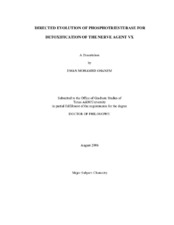| dc.description.abstract | Phosphotriesterase (PTE) isolated from the soil bacterium Flavobacterium sp. is
a member of the amidohydrolase superfamily. PTE catalyzes the hydrolysis of a broad
spectrum of organophosphate triesters including the insecticide paraoxon, and the
chemical warfare agents; GF, sarin, and soman. In addition, PTE has been shown to
catalytically hydrolyze the lethal nerve agent, VX. However, the rate of VX hydrolysis
is significantly slower. PTE was subjected to directed evolution studies to identify
variants with enhanced activity towards VX hydrolysis. First generation libraries
targeted amino acid residues in the substrate binding site. The H254A mutation
displayed a 4-fold enhancement in kcat and a 2-fold enhancement in kcat/Km over wild
type PTE. The double mutant H254Q/H257F was isolated from the second generation
libraries and displayed a 10-fold enhancement in kcat and a 3-fold enhancement in
kcat/Km. In addition, H254Q/H257F displayed a 9-fold enhancement in kcat/Km for the
hydrolysis of the VX analog, demeton-S.
An in vivo selection approach utilizing organophosphate triesters as the sole
phosphorus source is discussed. The selection is based on co-expressing PTE with the
phosphodiesterase (GpdQ) from E. aerogenes. Substrate specificity of GpdQ was investigated using a small library of structurally diverse organophosphate diesters and
phosphonate monoesters. Results obtained from the in vivo growth assays showed that
GpdQ enabled E. coli to utilize various organophosphate diesters and phosphonate
monoesters as the sole phosphorus source. Cells co-expressing PTE and GpdQ were
tested for their ability to utilize two different organophosphate triesters as the sole
phosphorus source. The results from this experiment indicate that the growth rate is
limited by the phosphotriesterase activity.
Protein translocation to the periplasm was proven advantageous for in vivo
selection since it overcomes the limitation of intercellular delivery of the substrate of
interest. Translocation of PTE to the periplasmic space of E. coli was examined. Two
signal peptides were tested; the native leader peptide from Flavobacterium sp. and the
signal sequence of alkaline phosphatase. The results obtained from cellular fractionation
indicated that neither signal peptides were able to translocate PTE to the periplasm and
that the protein remained in the cytoplasm. | en |


